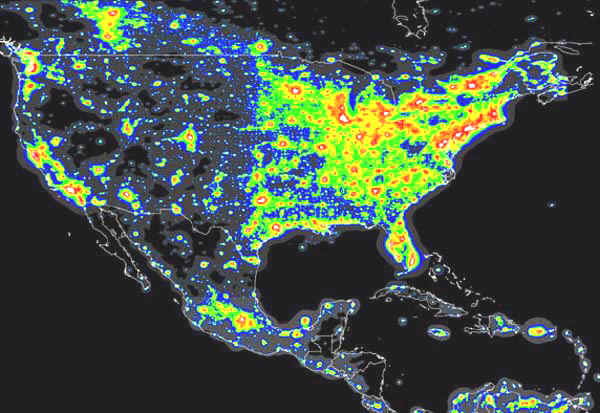Light pollution limits the visibility of the Milkyway to the unaided eye, the visiblity of nebulae and galaxies seen in telescopes, and raises the noise on CCD astrophotographs. Only the observation of planets and double stars is unaffected. Low light pollution conditions, or dark skies, is one of the most important properties of a good astronmical observing site. Unfortunately light pollution is a real hinderence to the amateur astronomer. A number of cities in the U.S. have developed standards for outdoor lighting to protect the rights of their citizens against light trespass. To assist them, the International Dark-Sky Association has developed a set of model lighting ordinances. The Dark-Sky Association was started to reduce the light going up into the sky which reduces visibility of stars, see sky glow below. You may also see more information on the dark sky issue at their
YouTube page. |
 |
This map is a small excerpt (171mi east to west, by 230mi north-to-south) from the image of North America from The World Atlas of the Artificial Night Sky Brightness. The central cross marks the location of the Ames clear sky chart. Tiny crosses mark other charts. This map assumes an observer at sea level. A real observer should see a slightly darker sky.
Credit: P. Cinzano, F. Falchi (University of Padova), C. D. Elvidge (NOAA National Geophysical Data Center, Boulder). Copyright Royal Astronomical Society. Reproduced from the Monthly Notices of the RAS by permission of Blackwell Science. |
In North America the situation is comparable. There is a significant problem with light pollution ranging from the Canadian Maritime Provinces to the American Southwest. There is a distinct line that follows Interstate 35 that divides the country east and west. From I35 east the seeing is terrible, whereas the southwest is the best. We have some fairly dark skies in westurn Iowa too!
Check out the
Iowa Star Party for more information about viewing there! |
 |
|

The SkyMap above is known as the astronomer's forecast. At a glance, it shows when it will be cloudy or clear for up to the next two days. It's a prediction of when Ames, IA, will have good weather for astronomical observing. The data comes a forecast model developed by Allan Rahill of the Canadian Meteorological Center.
CMC's numerical weather forecasts are unique because they are specifically designed for astronomers. |